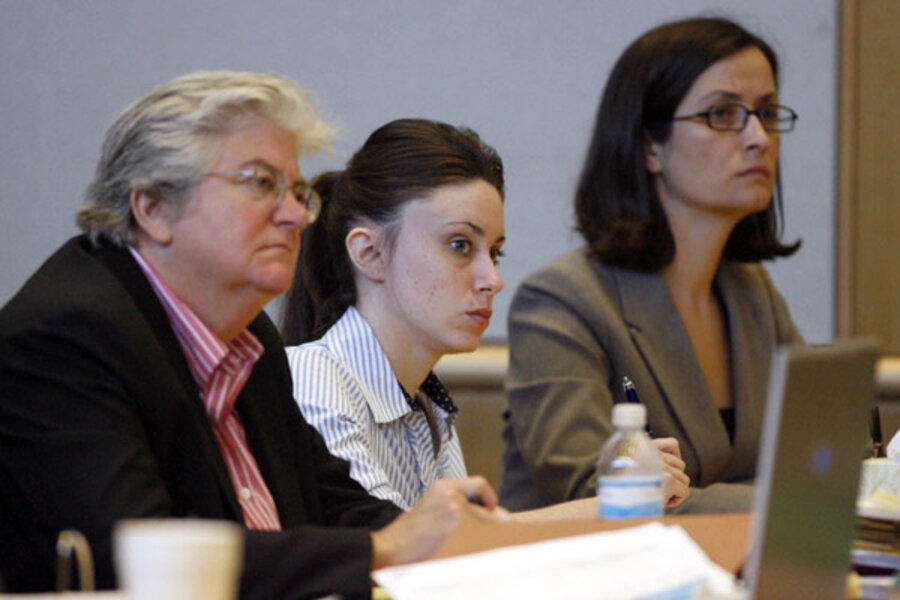Casey Anthony murder trial a test of cutting-edge forensic science
Loading...
After years of lurid details in newspapers and tabloid television shows, the trial of a young Florida woman accused of murdering her 2-year-old daughter is set to begin Tuesday in Orlando.
The case is a tragedy, a mystery, and a real-life soap opera rolled into one, and it has attracted intense interest across the country. It may also become an important test of cutting-edge forensic science in the courtroom.
Casey Anthony is charged with first-degree murder in the death of her daughter, Caylee, who was last seen alive on June 16, 2008.
Caylee's remains were discovered six months later in a wooded area not far from her home. Investigators say there appeared to have been duct tape over her mouth, possibly adorned with a heart-shaped sticker.
If convicted, Ms. Anthony, 25, could be sentenced to death. She insists she is innocent.
Because of extensive pretrial publicity, Chief Judge Belvin Perry selected the 12-member jury and five alternates in Clearwater, Fla., a hundred miles west of the Orlando courtroom where the two-month trial is to take place. The five-man and seven-woman jury will be sequestered throughout the trial to prevent exposure to what is expected to be blanket media attention, including live coverage on TRUtv and daily updates and discussions on talk shows.
CNN crime queen Nancy Grace has made it her mission to cover every twist and turn in the murder case. She rarely refers to Anthony by her name, preferring instead the tabloid-style moniker “Tot Mom.”
The mother emerged as a prime suspect after police were notified in mid-July 2008 that Caylee had been missing for a month. Anthony told deputy sheriffs she suspected a baby sitter had kidnapped her. Asked why she hadn’t contacted law enforcement officials earlier, she told the deputies that she had been conducting her own search and investigation.
A lawyer has also suggested that Anthony was worried that if she went to police the toddler would be harmed.
Police were unable to locate the person Anthony said was the baby sitter. A woman with the same name that Anthony provided to police told authorities she’d never met the mother or her daughter. She has since filed a defamation lawsuit against Anthony for harming her reputation.
Police quickly shifted their focus to Anthony when a number of her initial statements were found to have been false or deceptive. In addition, the young mother’s demeanor raised questions about her state of mind and why she did not seem upset or worried about Caylee.
Less than a week after Caylee went missing, Anthony was photographed laughing and partying at an Orlando night club, according to news reports. In addition, two weeks after Caylee’s disappearance, court records show, Anthony got a tattoo. It said: Bella Vita, Italian for “Beautiful Life.”
State prosecutors do not have direct evidence of Anthony’s involvement in her daughter’s death. No fingerprint-laden murder weapon has been recovered. The cause of death has not been determined. And no witnesses have come forward identifying the person or persons who dumped the body.
In addition, Anthony has made no incriminating statements either to investigators or to others that would amount to a confession. Throughout her pretrial detention, investigators have monitored her conversations with her parents and placed her in cells with potential informants who encouraged her to talk about her daughter.
What prosecutors do have is evidence of a stain and a foul smell that has lingered in the trunk of Anthony’s 1998 Pontiac Sunfire. A major portion of the state’s case against Anthony is aimed at proving to the jury that the foul odor is a remnant of the toddler’s decaying body.
Prosecutors have suggested that Anthony may have kept her daughter’s body in the trunk of her car for 11 days.
They plan to call as a witness Arpad Vass of the Oak Ridge National Laboratory in Tennessee. Dr. Vass used highly sensitive scientific instruments to test air and carpet samples from the trunk of Anthony’s car.
He said the odor in the trunk included the presence of compounds found during the early stages of decomposition of a dead human body, according to court documents. But he was unable to state with certainty that the odor was from a decaying human corpse.
Vass also found an unusually large indication of chloroform in a sample taken from the trunk, documents show. He said the quantity detected “was about 10,000 times greater than what we would expect.”
Investigators also discovered that someone had used a computer in the Anthony home to conduct Internet research into how to make chloroform.
Experts retained by defense lawyers say the scientific instruments Vass used are too new and untested to produce reliable evidence for use in a capital murder trial. They say the technology is promising but needs to be verified by other researchers and criminologists.
Defense lawyers have countered prosecution claims about the foul smell in the car by noting that at one point a bag of rotting garbage was left inside Anthony’s car trunk while it was parked outside in the hot sun for several days.
Prosecutors are also expected to present forensic evidence of a strand of hair found in the trunk of the car. Although several hairs were discovered – one of them, identified as Q12 – shows signs of post-mortem hair banding, according to court records.
Forensic experts say such banding can be an indication that the hair had fallen from the head of a corpse. But it is not the only possibility, they say.





